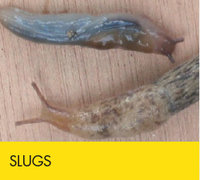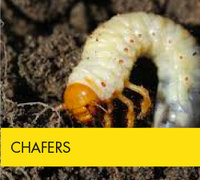Grass Pest Identification

The Grey Field Slug (Deroceras reticulatum) is particularly active in wet seasons especially on the heavier soil types.
It feeds on the shoots of newly germinated seeds, killing the plant entirely and may leave large areas completely devoid of plants.
Damage is therefore most likely on direct reseeded leys. Other symptoms include shredding of the leaves of older plants. Slime trails would also be obvious.

The larvae of several species of chafer beetle can also cause damage to grassland in various parts of the UK. The adults are 8-10 mm long with a green head and thorax and reddish brown wing cases:
- The grubs are white and about 18-20 mm long when fully grown
- The feeding of the larvae produces patches of poorly grown grass that may turn very brown in dry weather
- Damage is most likely to be seen in September–October
- Substantial bird activity may indicate infestation, as they actively search out the grubs
- Once infested, pastures tend to be re-infested in subsequent seasons unless they are treated with an appropriate agrochemical.

This larva of the Frit fly (Oscinella frit) attacks all cereal and grass crops, especially those following grassy stubbles or grass.
The Frit fly larvae are yellow-whitish in colour and can grow to 5 mm long.
To help prevent Fritfly, leave a 10 week gap between the previous grass crop or grassy stubble. If grass is sown after, grass seedlings will be attacked by larvae migrating out of the old sward in addition to those hatching from eggs laid by incoming adult flies. The problem is more acute in direct drilled reseeds than reseeding after ploughing.

Leatherjackets are the larvae of Crane-flies (Tipula spp), also known as Daddylong-legs. These soil living larvae cause considerable damage to roots and stems of many agricultural and horticultural crops, particularly of young plants.
- Legless, grey brown thick, tough wrinkled skin - growing to about 2 inches in length
- On established grassland high infestations may result in large bare patches appearing in the field. With low levels of infestation spring growth may be impeded.
- Reduces yield and, at the economic threshold of 1 million leatherjackets per ha, the weight of leatherjackets feeding below ground can be greater than the weight of livestock above ground. New sowings or reseeded leys may be completely destroyed
- The presence of large numbers of rooks, crows and starlings also indicates the presence of large populations of leatherjackets.

